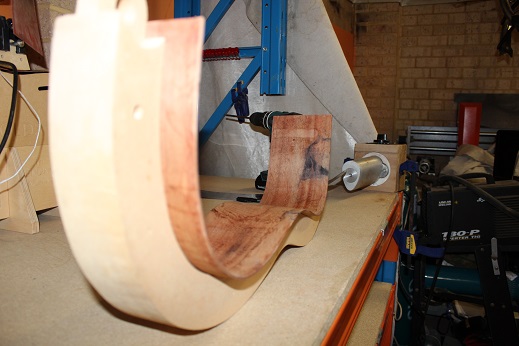
 |
|
#1
|
|||
|
|||
|
I have a mold for a cutaway guitar I want to build. I need to make a bending form for both sides. When making a bending form, do I need to overcompensate the bends to allow for springback? I’m more concerned about the cutaway side instead of the non-cutaway side, because of the tight curves involved.
|
|
#2
|
|||
|
|||
|
I personally dont make a special mold for a cutaway, I use the same mold as I would for a full body, the only difference is I have a cut slot into my mold to allow for the cutaway edge to sit into.
IMO nothing wrong with some spring back, but again, I like my bent sides to sit comfortably into the mold shape. Steve 
__________________
Cole Clark Fat Lady Gretsch Electromatic Martin CEO7 Maton Messiah Taylor 814CE |
|
#3
|
|||
|
|||
|
Steve, I think he's asking about forms over which to bend the sides.
Usually, yes, add a little additional curvature to allow for some spring-back. However, it depends somewhat on how you are bending the sides how much additional curvature to add. |
|
#4
|
|||
|
|||
|
Yes, thatís what I meant. Should I be making the curves tighter or deeper to allow for springback, and if so, how much? If thatís the case, itís going to be trial and error. I was trying to come up with some idea for a universal form in which you could just set several points that the curves need to wrap around. If it was off, you could just re-adjust the points and try again. It would be easier than cutting a whole new form and wasting more plywood.
|
|
#5
|
|||
|
|||
|
Quote:
I will try again. Here is Taylors bending process, they have an automated strap bending unit, no fixed form, apparently they can program for different woods and thickness's, note the amount of extra bending they do and the springback after its removed from the bender. When i use a form, i find I need to do some hand bending to achieve a neat fit into my mold https://www.youtube.com/watch?v=e6D4Dg-9MZY
__________________
Cole Clark Fat Lady Gretsch Electromatic Martin CEO7 Maton Messiah Taylor 814CE Last edited by mirwa; 08-24-2019 at 07:20 AM. |
|
#6
|
|||
|
|||
|
Quote:
I use 1/4" deeper at the waist, 1/2" deeper at the ends. If necessary, I'll touch-up using a hot pipe. Quote:
Those points are the extremes of upper and lower bouts, the waist and the two end points. If you lay it out on an X-Y grid, where Y is along the centreline of the guitar and X is along the width of the guitar, moving those points in X and Y directions will give you all of the shapes that can be made in a standard non-cutaway guitar. From a bending form point of view, the catch is "a smooth curve passing through those points". In the real world of bending, you'd need intermediary support to prevent kinks over those defining points. You might be successful with a series of sliding pieces that can be positioned to meet the defining points while also providing intermediary support between those points. The original Charles Fox side bender had individual slats bolted together for the waist press. Loosen the bolts, allows the individual slats to slide laterally to conform to whatever waist contour one has, then tighten the bolts to form a solid adjustable-shape press. In theory, one could make the entire form from bolted together narrow slats, then loosen the bolts and slide the slats to conform to any shape you want. The original bender was heated with light bulbs and needed to be "hollow". If you are using a different heat source, such as a blanket, the form doesn't need to be hollow. The question is, is it worth the trouble to do all that compared to the effort to occasionally make a new plywood/MDF form? In the original versions of the bender, the plywood contours were spaced using 1/2" metal bars. The plywood forms were drilled at their edge to have the surface of the bars tangent to the edge of the form. Charles used a drill press jig that positioned a correct distance from the edge the 1/2" holes for the metal bars, simplifying that portion of the form-making. It takes me about an hour to make a form. If you are frequently changing shapes, you might consider building using formless methods, including bending over a hot pipe. Skilled folks can bend a pair of sides over a pipe in 20 minutes. Or, if you are planning to open a factory, you can automate the whole thing such as Taylor has. 
Last edited by charles Tauber; 08-24-2019 at 07:16 AM. |
|
#7
|
|||
|
|||
|
I’ll have to look into the Fox bender. It sounds good for at least prototyping shapes on the fly. And I need to definitely try hand bending on the hot pipe again. I tried bending binding years ago on one and snapped every dang piece and haven’t tried it again since. Maybe I need to revisit that and try with sides and not binding.
|
|
#8
|
|||
|
|||
|
Bindings can be more fragile to bend, particularly if the binding material hasn't been selected to minimize runout.
|